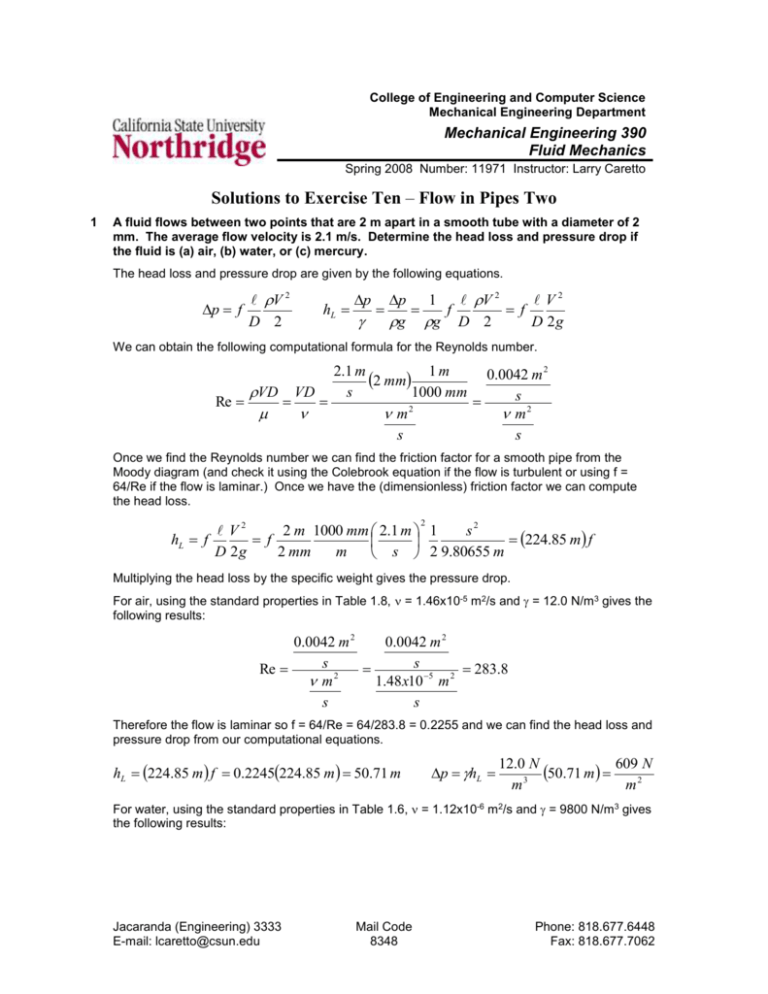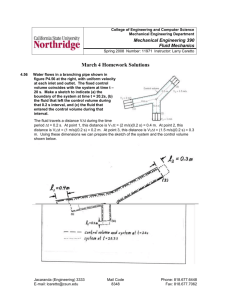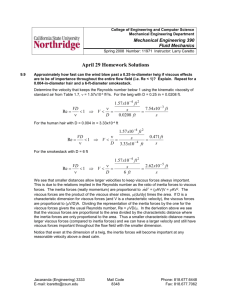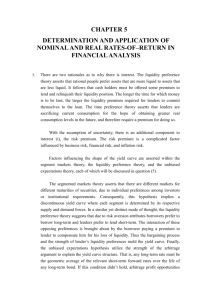Unit 10: April 17
advertisement

College of Engineering and Computer Science Mechanical Engineering Department Mechanical Engineering 390 Fluid Mechanics Spring 2008 Number: 11971 Instructor: Larry Caretto Solutions to Exercise Ten – Flow in Pipes Two 1 A fluid flows between two points that are 2 m apart in a smooth tube with a diameter of 2 mm. The average flow velocity is 2.1 m/s. Determine the head loss and pressure drop if the fluid is (a) air, (b) water, or (c) mercury. The head loss and pressure drop are given by the following equations. p f V 2 D 2 hL p p 1 V 2 V2 f f g g D 2 D 2g We can obtain the following computational formula for the Reynolds number. 2.1 m 0.0042 m 2 2 mm 1 m VD VD s 1000 mm s Re 2 m m2 s s Once we find the Reynolds number we can find the friction factor for a smooth pipe from the Moody diagram (and check it using the Colebrook equation if the flow is turbulent or using f = 64/Re if the flow is laminar.) Once we have the (dimensionless) friction factor we can compute the head loss. 2 V2 2 m 1000 mm 2.1 m 1 s2 hL f f 224.85 m f D 2g 2 mm m s 2 9.80655 m Multiplying the head loss by the specific weight gives the pressure drop. For air, using the standard properties in Table 1.8, = 1.46x10-5 m2/s and = 12.0 N/m3 gives the following results: 0.0042 m 2 0.0042 m 2 s s Re 283.8 m2 1.48 x10 5 m 2 s s Therefore the flow is laminar so f = 64/Re = 64/283.8 = 0.2255 and we can find the head loss and pressure drop from our computational equations. hL 224.85 m f 0.2245224.85 m 50.71 m p hL 12.0 N 50.71 m 6092N 3 m m For water, using the standard properties in Table 1.6, = 1.12x10-6 m2/s and = 9800 N/m3 gives the following results: Jacaranda (Engineering) 3333 E-mail: lcaretto@csun.edu Mail Code 8348 Phone: 818.677.6448 Fax: 818.677.7062 Exercise ten solutions ME 390, L. S. Caretto, Spring 2008 Page 2 0.0042 m 2 0.0042 m 2 s s Re 3750 2 m 1.12 x10 6 m 2 s s This is in the transition region. To get an upper limit on the pressure drop we will use the turbulent friction factor. From the Moody diagram for smooth tubes and Re = 3750 we find f = 0.0404. Checking this using the Colebrook equation gives. D 1 2.51 2.0 log 10 f 3.7 Re f 2.51 2.0 log 10 0 4.955 3.7 3750 0.0404 f 0.0407 Using this friction factor, we can find the head loss and pressure drop from our computational equations. hL 224.85 m f 0.0407224.85 m 9.158 m p hL 9780 N 8.956 x10 4 N 9 . 158 m m3 m2 For mercury, using the standard properties in Table 1.6, = 1.15x10-7 m2/s and = 13300 N/m3 gives the following results: 0.0042 m 2 0.0042 m 2 s s Re 36,521 m2 1.15 x10 7 m 2 s s Since Re > 4000, this is turbulent flow. From the Moody diagram for smooth tubes and Re = 36521 we find f = 0.0220. Checking this using the Colebrook equation gives. D 1 2.51 2.0 log 10 f 3.7 Re f 2.51 2.0 log 10 0 60631 3.7 36521 0.0220 f 0.0227 Using this friction factor, we can find the head loss and pressure drop from our computational equations. hL 224.85 m f 0.0227224.85 m 5.114 m 2 p hL 13300 N 6.801x10 5 N 5 . 114 m m3 m2 Coffee flows through the filter shown in the figure at the right at a rate of 4 mugs/min = 60 in3/min. Determine the loss coefficient for the filter. Show that it is reasonable to neglect major losses. We can write the energy equation between (1) the top surface of the filter basket (inlet) and (2) the surface of the liquid that is 4 in below the top (the outlet). z2 p2 V22 p V2 z1 1 1 hL . 2g 2g Since both surfaces are open to the atmosphere we have p1 = p2 = 0. Both surfaces will have a slow velocity so V1 V2 0. The elevation difference z1 – z2 = 4 in, is the only other term besides the head loss left in the equation. Thus we conclude that hL = 4 in. Exercise ten solutions ME 390, L. S. Caretto, Spring 2008 Page 3 Assuming that all losses are due to the filter, the corresponding loss coefficient for the filter can be written as follows, where V is the velocity in the 2 in diameter section of the filter holder. hL K L V2 2g KL 2 ghL V2 The velocity is found from the flow rate and area. 60 in 3 min Q Q min 60 s 1 ft 0.0265 ft V 2 A D s 2 in 2 12 in 4 4 We can now find the loss coefficient. KL 2 ghL V2 2 32.174 ft 4 in ft 2 12 in s 0.0265 ft s 2 3.06 x10 4 Typical loss coefficients for entry and exit flows are about 1. We can check the head loss in the 3-in flow path in the filter holder, but we expect that this will also be small compared to the large loss over the filter. The Reynolds number for the flow in the 2-in-diameter portion of the filter holder is (using = 3.393x10-6 ft2/s at 200oF for hot coffee-making water) 0.0265 ft 2 in 1 ft VD VD s 12 in Re 1303 6 3.393x10 ft 2 s Therefore the flow is laminar so f = 64/Re = 64/1303 = 0.0491 and we can find the head loss due to the laminar flow over 3 in of this section. 2 V2 3 in 0.0265 ft 1 s2 hL f 0.0491 8.056 x10 7 ft 9.7 x10 6 in D 2g 2 in s 2 32 . 174 ft This is clearly negligible compared to the total head loss of 3 in. Thus, the head loss for the filter is the only significant loss and it is correct to attribute all the head loss to the filter in calculating its coefficient. 3 A particular car’s exhaust system can be approximated as 14 ft of 0.125-ft-diameter, castiron pipe with the equivalent of six 90o flanged elbows and a muffler. The muffler acts as a resistor with a loss coefficient of KL = 8.5. Determine the pressure at the beginning of the exhaust system if the flow rate is 0.10 ft3/s, the temperature is 250OF, and the exhaust has the same properties as air. First of all we will assume that we have steady flow instead of the pulsating flow that normally occurs in exhaust systems of reciprocating engines. We start with the energy equation between the beginning of the exhaust system (1) and the outlet to the atmosphere (2). V22 p1 V12 z2 z h 2g 1 2g L p2 Exercise ten solutions ME 390, L. S. Caretto, Spring 2008 Page 4 Assuming that the inlet and outlet of the exhaust system are at the same elevation we have z 1 = z2. For the outlet as a free jet at atmospheric pressure we have p2 = 0. If the density changes due to the pressure drop are small compared to the average pressure we will have a constant velocity so the velocity at the start of the exhaust system, V1, will be the same as the velocity of the exhaust exiting the system, V2. With these simplifications, and expanding the definition of head loss, our energy equation becomes. p1 V2 V2 hL f KL g D 2g 2g p1 2 V p1 f K L D 2 The flow velocity is found from the volume flow rate and the area. 0.10 ft 3 Q Q 8.149 ft s V 2 2 A D s 0.125 ft 4 4 We find the dynamic viscosity of air at 250oF by interpolation in Table B.3: = 4.73x10-7 lbfs/ft2. Because the density is inversely proportional to temperature we will use an interpolation in inverse absolute temperature to find the density at the given temperature. 0.001624 slug 0.001870 slug 0.001870 slug ft 3 ft 3 1 1 ft 3 759.67 R 659.67 R 0.001738 slug 1 1 ft 3 709.67 R 659.67 R We now have the data necessary to compute the Reynolds number. 0.001738 slug 8.149 ft 0.125 ft VD s ft 3 Re 3743 4.73x10 7 ft 2 s This is in the transition region so we will use a turbulent flow approximation to compute the friction factor. The roughness for cast iron is 0.00085 ft (Table 8.1), so the relative roughness = /D = (0.00085 ft)/(0.125 ft) = 0.0068. For this relative roughness and Reynolds number, the Moody diagram gives a friction factor of 0.047. Checking this with the Colebrook equation gives. D 1 2.51 2.0 log 10 3.7 Re f f 2.51 2.0 log 10 0.0068 4.614 3 . 7 3743 0 . 047 f 0.0470 The six elbows each have a loss coefficient of 0.3. Assuming that we are looking at the pressure at the start of the pipe, after the entrance loss and the pressure just at the exit before the exit loss the sum of the head loss coefficients is 6(0.3) = 1.8 for the elbows and the given value of 8.5 for the muffler. Using the total of 1.8 + 8.5 = 10.3 for the sum of the loss coefficients, we find the pressure at the start of the system as 2 2 2 1 0.001738 slug 8.149 ft 1 lb f s 14 ft V p1 f K L 0.0470 10.3 0.125 ft s ft 3 D 2 slug ft 2 p1 = 0.898 psf










